Bridging the Language Gap
3 min read

Article by Mundi Cox on defining the future of skills in the Cultural and Creative Sectors and Industries.
From its very inception in 2022 the EU-funded project, CYANOTYPES, has brought together more than 40 partners and associate partners from 18 countries around Europe, all coming together with the aim of facilitating joint efforts to address skills gaps and future skills in the creative sector. Drawing its name from the work of Anna Atkins, an eighteenth-century botanist and photographer who incorporated new technologies (cyanotyping) to document algae in blueprints, CYANOTYPES is also inspired by the diversity of creative innovation and the potential it offers.
While the scope of the project is beneficial due to the multiple minds working together in congruence, the broader Cultural and Creative Sectors and Industries (CCSI) that it functions within are rather fragmented, which raises the risk of miscommunication amongst members of different industries, sectors and countries; especially considering the varying levels of support that different countries offer to their creative industries.
To better understand the communicational hurdles that have emerged in certain stages of CYANOTYPES, we interviewed Rita Grácio, professor and researcher representing Lusófona University, Ragnheiður Erla Björnsdóttir, artistic researcher representing University of Applied Arts Vienna, and Nerea Rojas Mendieta, Assistant Editor-in-Chief of World Leisure Journal; all whose experiences within the project highlight both the challenges faced and the solutions that have emerged as a result, such as the CYANOTYPES Project Glossary.

Because language is arbitrary, it comes as no surprise that project partners from different areas of the industry have certain preferences in relation to terms that may even refer to similar subjects. Within the occupational mapping sector, which involves creating detailed descriptions of job roles, Nerea points out that the biggest challenge they have faced has been the rapid evolution of industry-specific terminologies as well as shifting needs within various sectors. This presents the challenge of having to also anticipate the terminology that will emerge in the future.
The CYANOTYPES Project Glossary emerged as a way of standardising terminology across the board, allowing for clearer and more effective communication amongst stakeholders involved in the project. Furthermore, Rita rightly points out that the process to better understand each other began even before the definitions were compiled; participatory workshops served as a pathway to develop the glossary, allowing all voices to be heard. The glossary thus serves as not only a way to standardise the language, but rather to expand on it by introducing synonyms that can be better applied by members through this unified language.
The idea of the shared language is particularly crucial, notes Nerea; it aligns the future progression of job profiles with the rapid developments in industry and technology, thereby ensuring that the workforce remains competent and competitive. And through an inclusive process of prioritisation that ensured that no voice, vision or opinion is marginalised, Rita affirms that there is a shared sense of empowerment that is reflected amongst the teams in knowing that they are working on a project with true impact.
And while it is crucial to share a common language, it is also important to protect all perspectives and allow for a natural development of definitions wherever they emerge, as noted by Erla. The beauty of having such culturally diverse members and partners is also to learn from each other and adapt new modes of speaking about both similar and different subjects.

In similar vain to how CYANOTYPES, along with all EU-funded projects, is re-applicable in that its results will carry on and benefit further initiatives, emerging solutions such as the glossary have been modelled in a similar fashion to ensure that the terminology compiled during this period will serve future projects. In this way, the glossary will emerge as one of the renewable outcomes of CYANOTYPES rather than simply being a means to an end.
“’Participatory’ and ‘impactful’ would be the words I would best use to describe CYANOTYPES in terms of spirit.” –
Rita Grácio
. . .
